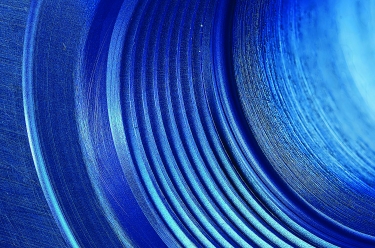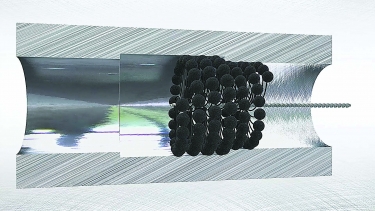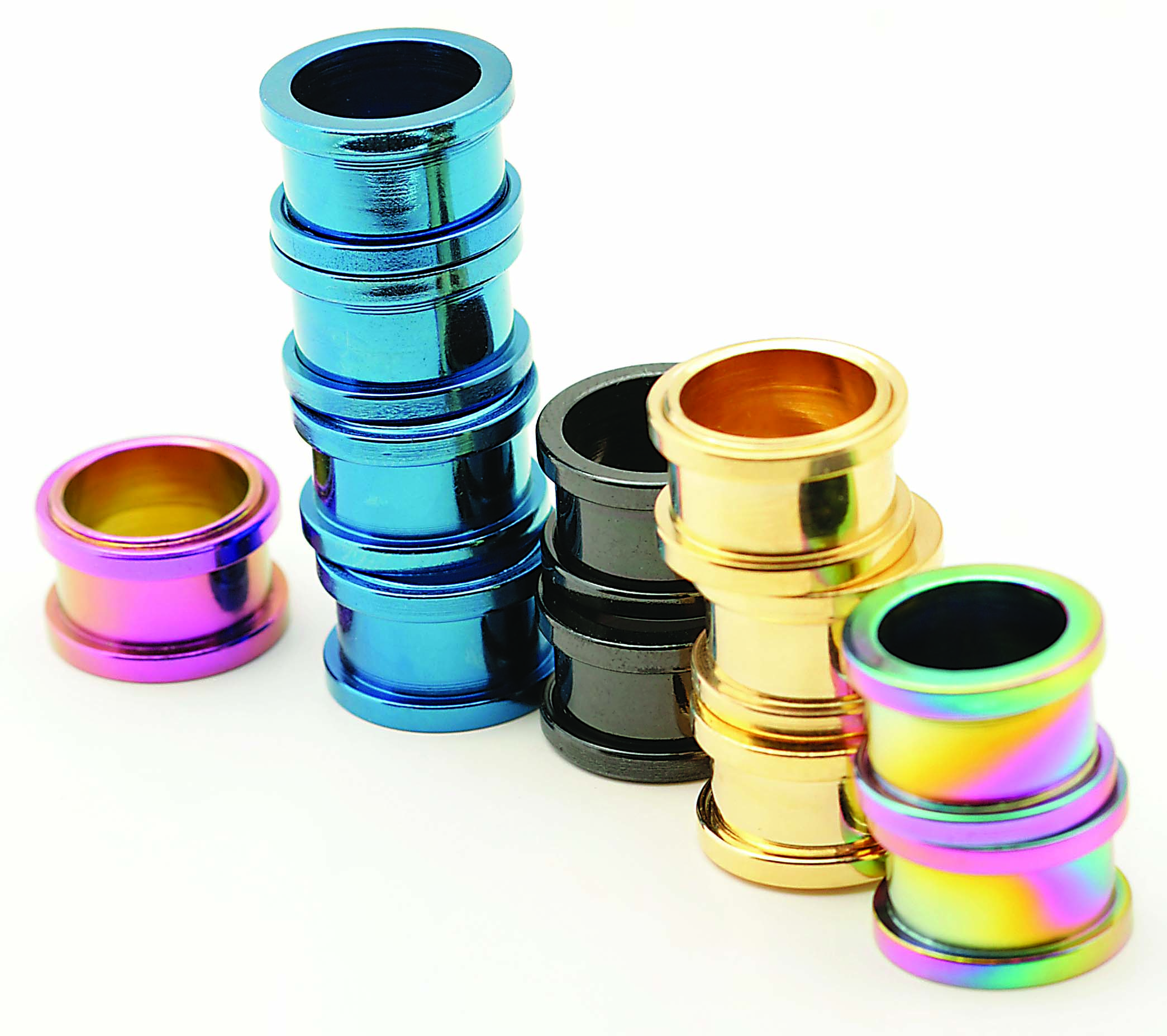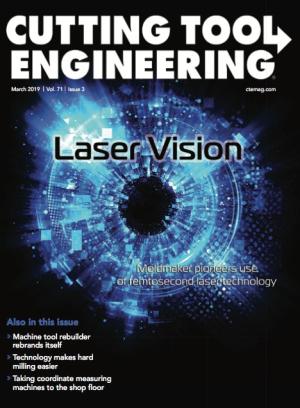
An example of the surface of an anodized cylinder. Image courtesy of Brush Research Manufacturing
To permit the use of aluminum instead of other, heavier metals in industrial applications, many cylinders are anodized to create an extremely hard surface that resists wear and corrosion, is nonconductive and is lubricious. Because anodized surfaces are porous, they also improve adhesion of coatings, as well as accept a variety of dyes for coloring. Given the myriad benefits, anodizing is popular for a variety of cylindrical items, including lift mechanisms for chairs; lift cylinders for hatchbacks; shock absorbers and forks for bicycles; fuel pumps; water pumps; pneumatic and hydraulic cylinders; spool valves; valve stems; and valve bodies.
By definition, however, the anodizing process means that part dimensions grow dimensionally and the surface finish becomes rougher. For a cylinder, that includes both an increase to the OD and a decrease to the ID. There are several types or classes of anodizing methods, and each reflects a range of coating thicknesses. As a rule, thicker coatings provide greater corrosion protection. Therefore, surfaces last longer in harsh environments, such as salt air.
As for surface finish, a hard coat anodized to 0.002" thickness generally results in an Ra two to three times the original bare metal finish. For example, a machined Ra of 16 easily can become 30 Ra or more after anodizing.
For many parts, this is not an issue. However, when a part is cylindrical and mates with another part, often using a seal, increased dimensions and a rougher surface finish can be problematic.
Anodic coatings are very hard—only slightly less hard than diamond and harder than hard-chrome plating—and increased surface roughness may abrade sealing materials. Seal wear and coating irregularities might provide a path for leaks.
For this reason, parts require a fine surface finish for reliable sealing and long component life. To accomplish this, many companies utilize honing tools as an economical approach for treating the surface before or after the electrochemical process to control the dimensions and create a smoother surface. The results are a cost-effective method to resolving finishing challenges in the anodizing process and the consistent yield of high-quality products at a competitive price.
Honing Tools
Manufacturers traditionally have used grinding, lapping and rigid honing to improve the surface finish of anodized and hard-coat anodized parts. For several reasons, however, machine setups are difficult and must be extremely precise. First, the anodized coating is very hard. Second, the total coating thickness is very thin. Third, the high and low points of the anodized coating are not absolutely symmetrical around the centerline of the cylinder ID. When rigid honing is used with anodized parts, the honing stones contact only the coating’s high points, so areas of the cylinder ID remain untouched.

Brush Research Manufacturing’s Flex-Hone imparts a fine finish to the ID of a cylinder. Image courtesy of Brush Research Manufacturing
Rigid honing has other issues. Because anodized coatings are thin, just a very small amount of material should be removed. Yet rigid honing works best with heavier cuts and greater material removal. Fine cuts combined with tool loading can contribute to smeared surfaces.
The Flex-Hone Tool from Brush Research Manufacturing Co. Inc., Los Angeles, provides a better way to improve the surface finish of anodized and hard-coated cylinders. The Flex-Hone consists of abrasive globules permanently laminated onto the ends of flexible nylon filaments. Because the diameter of the tool is greater than the diameter of the bore, the Flex-Hone is used in an oversized condition and self-centers, self-aligns and self-compensates for wear.
Importantly, the tool’s globules float to ensure that all parts of the bore—not just the high spots—are surface-finished. Unlike rigid honing machines, Flex-Hone setups are simple. Surface finishes can be improved with just a few strokes of the tool, and results are consistent.

Flex-Hone tools from Brush Research Manufacturing can address surface roughness and increased dimensional changes for anodized cylinders.
The tool may be used prior to anodizing to control the size in anticipation of shrinkage in ID. Honing also removes fuzz, sharp edges and any amorphous material that might adhere to the surface and affect the quality of the anodizing.
The most common use for the tool is after anodizing, when correcting unanticipated size and surface finish issues. When quality of the final anodized finish is of utmost importance, some users apply the tool before and after.
With anodized coatings, the recommended abrasive types are 400-, 600- or 800-grit Al2O3 and extra-fine levigated alumina. Choice of grit depends on the type and thickness of the anodized coating and the final surface finish specification. Flexible honing tools are available in sizes from 4mm to 36".
For more information, contact Brush Research Manufacturing Co. Inc. at 323-261-2193 or visit www.brushresearch.com.
Contact Details
Related Glossary Terms
- abrasive
abrasive
Substance used for grinding, honing, lapping, superfinishing and polishing. Examples include garnet, emery, corundum, silicon carbide, cubic boron nitride and diamond in various grit sizes.
- amorphous
amorphous
Not having a crystal structure; noncrystalline.
- grinding
grinding
Machining operation in which material is removed from the workpiece by a powered abrasive wheel, stone, belt, paste, sheet, compound, slurry, etc. Takes various forms: surface grinding (creates flat and/or squared surfaces); cylindrical grinding (for external cylindrical and tapered shapes, fillets, undercuts, etc.); centerless grinding; chamfering; thread and form grinding; tool and cutter grinding; offhand grinding; lapping and polishing (grinding with extremely fine grits to create ultrasmooth surfaces); honing; and disc grinding.
- inner diameter ( ID)
inner diameter ( ID)
Dimension that defines the inside diameter of a cavity or hole. See OD, outer diameter.
- lapping
lapping
Finishing operation in which a loose, fine-grain abrasive in a liquid medium abrades material. Extremely accurate process that corrects minor shape imperfections, refines surface finishes and produces a close fit between mating surfaces.
- outer diameter ( OD)
outer diameter ( OD)
Dimension that defines the exterior diameter of a cylindrical or round part. See ID, inner diameter.

